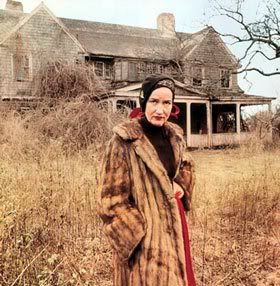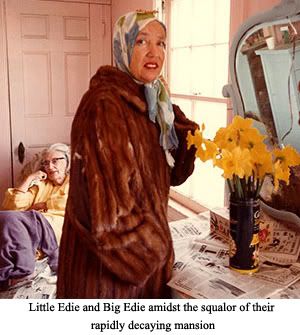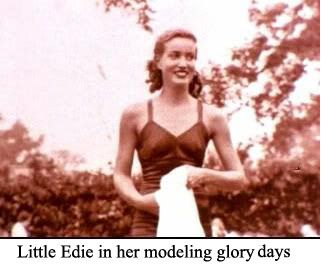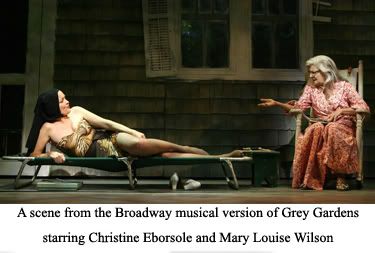Grey Gardens – A History
This coming weekend, many gay men over 30 will all be huddled together in unison watching the long awaited narrative film version of cult documentary Grey Gardens, starring Jessica Lange and Drew Barrymore. The original documentary Grey Gardens came out in 1975, nearly a quarter century before things like The Surreal Life, The Ana Nicole Show, and other such reality shows made weekly entertainment out of watching famous people have very public mental breakdowns in front of the cameras. For various reasons, Grey Gardens garnered a huge following of gay men, and now the beloved queer icons are about to be played by big Hollywood names. Can they do the real people being portrayed in the cult classic documentary justice?
A History of Grey Gardens
Grey Gardens is named for the estate of Edith Bouvier Beale (also known as “Big Edie”) and her daughter and namesake Edith (referred to as “Little Edie” well into her 50’s) These women were the aunt and first cousin of Jacqueline Bouvier Kennedy Onassis. Once rich and sort of/kind of famous, the Beales were true American Blue Bloods, the very definition of “Old Money”. Big Edie was a wannabe singer, who even managed to record a song or two in her day. Her daughter Little Edie was a fashion model, whose sole purpose in life (as it was for almost all women at the time) was to get engaged to the right man and be a good and loving housewife and socialite for the rest of her days. Despite having dated J. Paul Getty, as well as having been engaged to Joe Kennedy Junior, Little Edie never really found true love. The closest she came was when she had an affair with the married Julius Krug, then the U.S. Secretary of the Interior, while living at a dormitory for aspiring models in New York City. After the elder Edie’s husband, Phelan Beale, left his wife for another woman, the trust fund eventually ran out. Her two sons long since having moved on to their own careers and to the big city, the elder Edie asked (or forced, depending on who was asked) the younger Edie to leave New York City in 1952 and move back home. The two women then lived together at Grey Gardens, their 28 room estate in the posh East Hamptons in New York for the next 25 years. As the money slowly ran out, the mansion slowly crumbled around them, becoming a refuge to stray cats and even racoons. Eventually they even had their power and gas turned off, as the once rich and beautiful now lived in squalor and almost complete isolation from the outside world.

.
In the early 70’s their living conditions were exposed as the result of tabloid articles, after a series of inspections by the Suffolk County Health Department. The Beales called these inspections “raids” and were quoted by the papers calling the inspections “the worst thing to ever happen in the history of the United States”. Considering how the Beale’s world was pretty much made up of each other and no one else, one can kind of understand just how they could come to that conclusion. With the Beales now facing eviction, or worse, their home being condemned, Jacqueline Onassis provided the necessary funds to stabilize and repair the dilapidated house so that it would meet city codes. Jackie O. had barely any contact with her aunt and cousin over the decades, but allowing them to live in squalor like that would have been too much of an emberassment and made them her bad, so she really had no choice but to help.

It was into this situation that documentarians Albert and David Maysel, fresh from making the Rolling Stones documentary Gimme Shelter, asked the Beale women if they could be allowed to film their lives as they really were. After spending six weeks with the Beales, the Maysels created what could be considered the first “train wreck cinema” documentary. Grey Gardens really has no beginning, middle or end. The camera merely follows them around, as each day was more or less the same for the Beales. They get up, feed the animals, pull out old pictures from their glory days, reminisce, listen to old music, argue, make up, and start all over again. When asked by the film makers about her former husband, Big Edie would act as if her marriage was a happy one, despite the fact that her husband left her with three children and cut off her money. Little Edie blames and yells at her mother for chasing off every male suitor that came her way, and then later contradicts her own angry sentiments by saying she never really wanted to get married in the first place. Add to all this crazy drama a house falling in on iteslf, with the local wildlife partaking of the groceries, and you begin to understand what an insane asylum that house has become.

While the 80 something Big Edie has her share of moments in the film, like when she warbles along to one of her old records, its really Little Edie that steals the movie. Either displaying her crazy dance and modeling techniques for the camera, or wistfully pining awayfor the young single man who never came to rescue her from life with Mother, it is Little Edie who is the most tragic and fascinating figure in Grey Gardens. And then of course, there’s Little Edie’s fashion sense. Instead of wearing wigs, Little Edie instead wears a variety of scarves wrapped around her head to cover her hair loss, and inadvertently created a whole new kind of fashion. Her outfits, or “revolutionary costumes” as she likes to call them, are so out of left field its no wonder gay men love Grey Gardens so much. Little Edie’s outfits are fierce. Superstar designer Todd Oldham would later create a whole line of Little Edie’s signature look.

And as to just why gay men love Grey Gardens so much, I suppose it appeals to our love of both celebrity scandal, campy dialogue, and fierce women who create their own looks and attitudes and don’t give a flying fuck who thinks they’re wrong and need to be just like everyone else.

Recently there seems to be quite a Grey gardens revival, first by becoming a Tony Award winning Broadway musical in 2007, and now the new HBO version. The only sad thing is both Edies are no longer with us to enjoy their newly rediscovered fame. I can’t help but think they would have loved it, and probably would have wanted to become the country’s next big reality television stars themselves in the inevitable television follow up that would have no doubt happened, no doubt on either the Bravo or Logo networks. *Sigh* If only.
